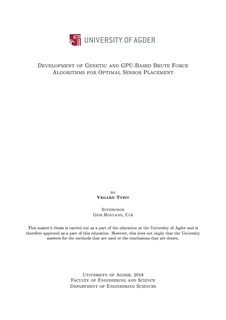Development of Genetic and GPU-Based Brute Force Algorithms for Optimal Sensor Placement
Master thesis
Permanent lenke
http://hdl.handle.net/11250/2564029Utgivelsesdato
2018Metadata
Vis full innførselSamlinger
Sammendrag
Optimal sensor placement is a complicated task where several parameters have to be considered simultaneously.
The problem has been a subject of much research in the last decades, but there does
not seem to be a consensus regarding how to solve the problem. With the increasing use of sensors in
a variety of applications, e.g. surveillance and motion tracking, optimal placement is desirable due to
the possible reduction of the total cost.
In this thesis, a method for solving the static 3D Sensor Placement Problem is presented. From a
3D model of the environment, the constraints of the problem can be de ned in the User Interface,
including Regions of Interest, sensor parameters, possible sensor positions and discretization accuracy.
The User Interface is developed in Matlab, utilizing a variety of functions and scripts.
Based on the output data from the User Interface, several optimization algorithms are developed and
compared. First, a traditional Greedy Algorithm is developed in C++. This algorithm is extremely
fast, but it has been proven to be sub-optimal. A Brute Force Algorithm is also developed in C++,
to guarantee the global optimum. Since this algorithm computes the coverage of all possible sensor
placement combinations, it will always produce the same result, which is guaranteed to be the global
optimum. The Brute Force Algorithm requires vast amounts of computational power for more complex
problems, and it has been shown that a threshold exists where the Brute Force Algorithm is not feasible
due to hardware and computational time restrictions. To enable the use of the developed Brute Force
Algorithm in more complex problems, it is converted to CUDA for utilization of a GPU. By converting
the problem to CUDA, a considerable speedup was achieved, enabling the use of the GPU-Based Brute
Force Algorithm on more complicated problems.
A Genetic Algorithm has also been developed in Matlab. The Genetic Algorithm is a meta-heuristic
algorithm; hence it can not guarantee to produce the global optimum. By designing suitable genetic
operators and investigating the e ect of parameter tuning, a method has been developed which has
proven to produce the optimal results for all veri able tests. This algorithm converges to a solution
much faster than the GPU-Based Brute Force Algorithm, also needing less computational power.
Beskrivelse
Master's thesis Mechatronics MAS500 - University of Agder 2018

